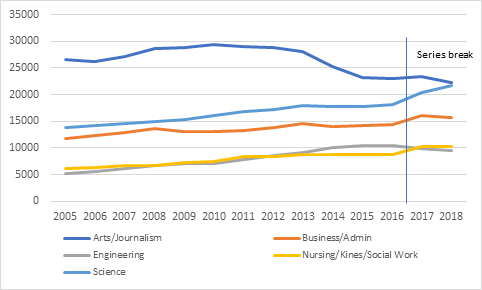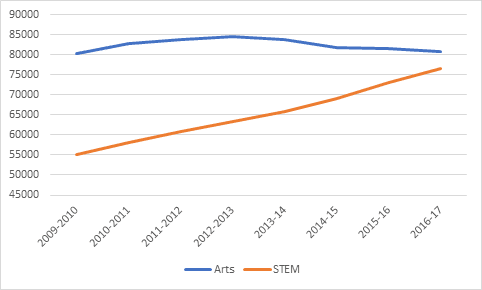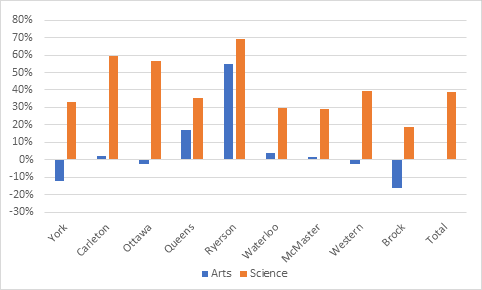Last week I did a blog about changes in applications to Ontario universities by field of study which included this graph, which seems to have freaked a lot of people out.
Figure 1: Applications to Ontario Universities by Field of Study, 2005-2018
But this is just an indication of student preferences. So I wondered to myself: have Ontario’s universities actually adapted to this shift and changing their admissions and enrolment patterns, or do we have a lot of frustrated wannabe- engineering/science students?
So I decided to do a quick check of Ontario institutions and their enrolment patterns since 2009. The focus was solely on STEM (i.e. science and engineering) vs. Social Sciences and Humanities (Fine Arts gets lumped in with the latter at some but not all schools): to simplify the analysis I ignore changes in fields like Education, Business, and Health.
I tried to include all thirteen Ontario institutions with more than 10,000 undergraduate students. However, three of them (Guelph, Windsor, Laurier) do not have 2016-17 data on their websites, so I eliminated them from the group. I also unfortunately had to ditch the University of Toronto, because they appear not to be able to distinguish Arts students from Science students (it is a single faculty there). So that left nine institutions, which together make up 62% of all undergraduate enrolments in the province, which is less than ideal but still probably good enough to examine broad trends.
Here’s what I found.
Figure 2: Enrolments in Arts and STEM subjects, 2009-2016, 9 Ontario Universities.
Arts enrolments rose slightly and fell slightly over the period, to end at roughly where they were at the start of the period. STEM enrolments, on the other hand, rose by nearly 40% in just seven years. Which is honestly pretty astonishing. We don’t have data for this year yet, but it seems likely that for 2017-2018 STEM enrolments across those nine institutions likely equaled or exceeded Arts enrolments.
Mind you, the growth pattern across institutions differs quite substantially. Take a look:
Figure 3: Changes in Enrolments in Arts and STEM subjects by institution, 2009-2016, 9 Ontario Universities.
Basically, there seem to be three types of institutions. There is Brock and York, which are seeing significant increases in STEM enrolment and significant decreases in Arts enrolment. There is Carleton, Ottawa, Waterloo, McMaster and Western, all of which are seeing significant increases in STEM enrolments and essentially stagnant Arts enrolment. And then there are Queen’s and Ryerson who are seeing increases in both areas.
(I am pretty sure that the York and Ryerson figures for Arts are related, by the way. York has seen a significant drop in first-choice applications over the past few years, mostly due to bad publicity generated by strikes, and Ryerson has been the primary beneficiary of this. Queen’s Arts on the other hand, just grows because it can; as a prestigious institution, it continues to receive plenty of interest and applications even as applications system-wide fall.)
So, the answer seems to be that institutions are on the whole sensitive to demand, and that they will change their enrolment patterns in response to changes in patterns of applications. But the real question is, given that profs can’t re-locate from one field of study to another, how well have faculty complements adapted to this change?
Tune in tomorrow, because the answer is pretty stunning.




 Tweet this post
Tweet this post
